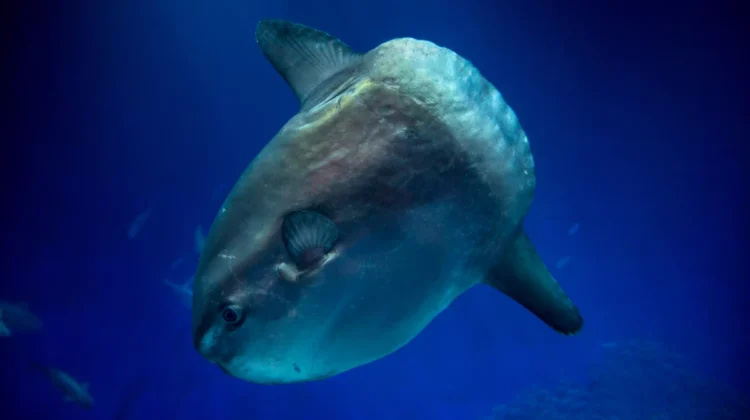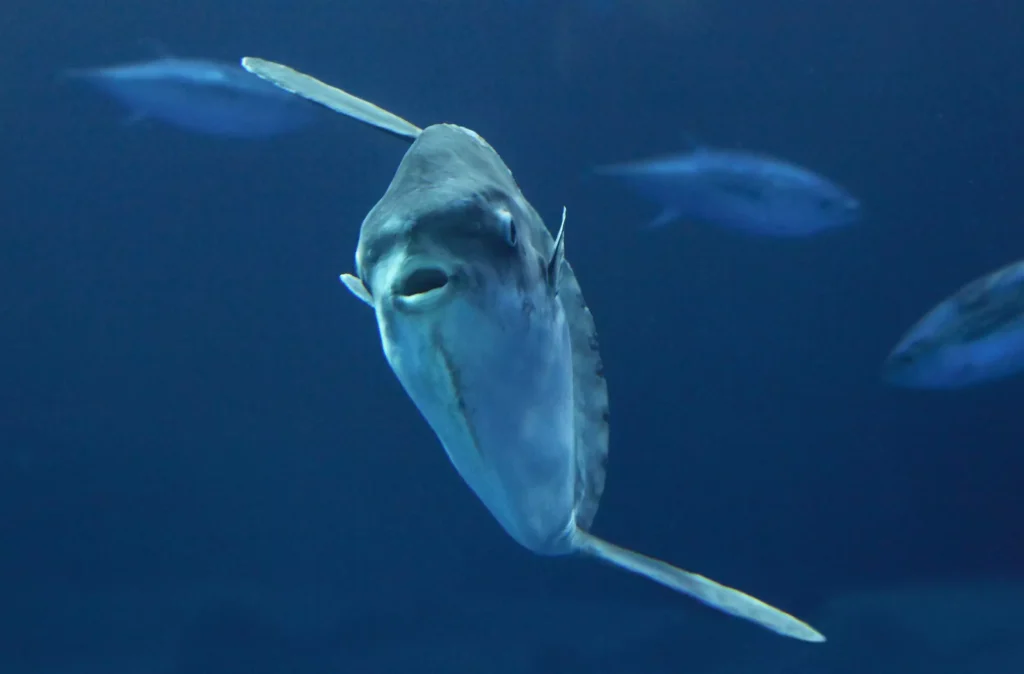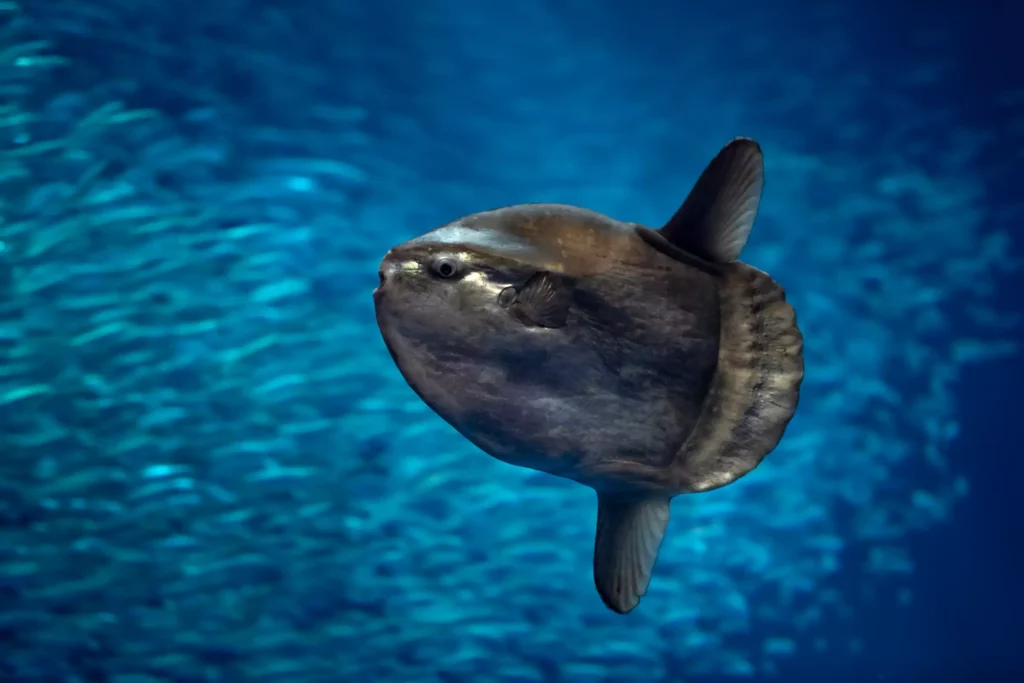
The ocean sunfish, scientifically known as Mola mola, presents a perplexing appearance that might seem like the result of a mad scientist’s experiment. This immense, flat-bodied fish, adorned in a silvery-gray hue, boasts a petite mouth and oversized eyes that appear to vanish into its even larger frame, complete with a truncated tail. Weighing in at a staggering 5,000 pounds (2,268 kg), the Mola mola claims the title of the world’s heaviest bony fish, excluding sharks and rays (with the whale shark being 10 times larger).

Animal Classification: The World of Fishes
Habitat: Roaming the Open Waters
Size: Reaching up to 10 feet in length and nearly 5,000 pounds; some Molas in Monterey Bay can weigh up to 1,000 pounds (454 kg) or more
Diet: Primarily consisting of jellyfish and other gelatinous zooplankton such as salps, squid, fish, crustaceans, and algae
Range: Widespread across tropical and temperate oceans globally
Relatives: Belongs to the Molidae family
Encounter at the Aquarium: Life in the Slow Lane
Visitors to our Open Sea exhibit might observe a blur of rapid movement as tunas and bonitos swiftly snatch their meals. But what about the leisurely ocean sunfish? Our aquarists have devised a unique method to cater to this gentle giant’s pace. They place a visual marker on the water’s surface, signaling mealtime and guiding the sunfish to its food.
Natural History: A Fish or a Work of Art?

With its tank-like physique, the Mola mola appears ill-suited for life in the fast lane. Yet, it holds its own among speedier and flashier fish species and thrives in nearly all the world’s oceans. While it’s known to spend time near the ocean’s surface, research indicates that the Mola mola is also an accomplished diver, embarking on long-distance migrations at significant depths.
From a minuscule egg, the Mola mola undergoes an astonishing transformation, growing to weigh more than a pickup truck—increasing its weight by a staggering 60 million times! This equates to a 1-gram tadpole becoming a 60-ton frog. As the heaviest bony fish, it can reach lengths of up to 10 feet (3 m) but often stands taller than its length, extending up to 14 feet (4.3 m) from dorsal fin to anal fin. Its distinctive feature is the clavus, a scalloped muscle fringe on its blunt rear end, used as a rudder.
Breakfast Choices: Unconventional Dining Habits
Within the Mola mola’s tiny mouth reside two pairs of hard teeth plates, characterized by a slightly curved ridge resembling a bird’s beak. Its primary diet consists of jellyfish and various gelatinous organisms, ranging from sizable moon jellies to ctenophores and minuscule comb jellies. Instead of chewing, the Mola mola sucks these organisms in and out of its mouth, reducing them to gelatinous chunks. The presence of a mucus-like lining in its digestive tract prevents stings. On occasion, the Mola mola indulges in squid, fish, algae, crustaceans, and other invertebrates, often making vertical migrations to locate deeper-dwelling gelatinous prey in the open ocean.
Sluggish Swimmers: Defying Expectations
In contrast to most large pelagic fish, the Mola mola is a leisurely swimmer and lacks a gas-filled swim bladder, typically responsible for precise buoyancy control in bony fish. Initially believed to drift with ocean currents, Molas in Southern California have defied expectations, swimming up to 16 miles (26 km) in a day, achieving a top speed of two miles (3.2 km) per hour—a commendable feat for a creature of its size. During its leisurely voyages, the Mola mola often shares its company with nearly 40 different parasite species, some of which carry their parasites, including gooseneck barnacles residing in its throat.
Mola mola on the Menu? An Unusual Culinary Choice
The Mola mola shares a family connection with pufferfish, displaying a puffy, round appearance covered in spines similar to its relatives. While certain parts of pufferfish are highly toxic, studies have found no trace of toxins in the Mola mola. Despite its parasite-ridden skin, reminiscent of a car tire, the Mola mola is a sought-after delicacy in parts of Asia and is utilized in traditional medicine. Its predators include sea lions, sharks, and killer whales, aside from humans.
Conservation Efforts: Protecting the Ocean Sunfish
The Mola mola’s propensity to drift near the ocean’s surface makes it susceptible to drift gillnets used by fishing boats. Although these nets don’t typically cause immediate harm, they can damage the sunfish’s skin, remove its protective mucus, and introduce air into its gills. Another threat comes from discarded plastic bags that resemble jellyfish—a favorite Mola mola meal. Ingested plastic can obstruct the sunfish’s stomach, leading to slow starvation. Hence, carrying reusable bags and ensuring proper disposal of plastic bags are vital for aiding Mola mola conservation.
The International Union for the Conservation of Nature and Natural Resources (IUCN) classifies the Mola mola as “vulnerable,” emphasizing the importance of safeguarding this unique ocean giant.

Leave a Reply